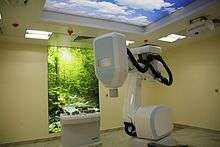Cyberknife
The CyberKnife System is a radiation therapy device manufactured by Accuray Incorporated. The system is used for treating benign tumors, malignant tumors and other medical conditions.[1] This device combines a lightweight linear accelerator mounted on a robotic manipulator and an integrated image guidance system. The image guidance system continually acquires stereoscopic kV images during treatment, tracks tumor motion, and guide the robotic manipulator to precisely and accurately align the treatment beam to the moving tumor. The system is designed for stereotactic radiosurgery (SRS) and stereotactic body radiation therapy (SBRT). The system is also used for select 3D conformal radiotherapy (3D-CRT) and intensity modulated radiation therapy (IMRT). The CyberKnife System is designed to deliver radiotherapy more accurately than standard radiotherapy devices.

The system was invented by John R. Adler, a Stanford University professor of neurosurgery and radiation oncology, and Peter and Russell Schonberg of Schonberg Research Corporation. The first system was installed at Stanford University in 1991 and was cleared by the FDA for clinical investigation in 1994. After years of clinical investigation the FDA cleared the system for the treatment of intracranial tumors in 1999 and for the treatment of tumors anywhere in the body in 2001. Since the original design, Accuray Incorporated released six CyberKnife System models over the years: the CyberKnife G3 System in 2005, the CyberKnife G4 System in 2007, the CyberKnife VSI System in 2009, and the CyberKnife M6 System in 2012.


See also
References
- ↑ Radiosurgery/Cyberknife. Stanford School of Medicine
Further reading
- Kilby, W; et al. (2010). "The CyberKnife® Robotic Radiosurgery System in 2010". TCRT. 9 (5): 433–452.
- Principles and Practice of Stereotactic Radiosurgery, Lawrence Chin, MD and William Regine, MD, Editors (2008)